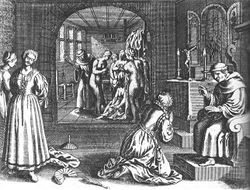Corporal punishment in religious institutions

Ever since the first monasteries and nunneries were built, they were not only places of faith and worship but also of education. Religious institutions expected people to follow not only secular laws, but also moral and religious commandments, plus, for their members, additional monastic rules. They were often notorious for their strict discipline and punishments.
Punishment scenarios
Punishment by religious authority figures occurred in different scenarios:
- punishment of members of a religious order (monks and nuns) for breaking monastic rules
- punishment of prospective members of a religious order (novices) for breaking monastic rules
- punishment of members of their parish by clerics for their sins (as penance)
- punishment of students, altar boys, etc. by clerics in loco parentis for misbehavior
- self-punishment as penance and for religious reasons (mortification of the flesh)
Punishment methods
Common methods of punishment in Christian religious institutions included exercises of penance (such as reciting prayers), extra work or chores, removal of privileges (such as fasting, no speaking, no sleep), confinement, wearing of a cilice, and corporal punishment.
Corporal punishment
[[Image:Monk.jpg|thumb|Penance, engraving by an unknown English artist, 18th century There was a lot of discussion whether corporal punishment should be given clothed or nude, and whether it should be administered to the shoulders and back, or to the buttocks. They ended up with two schools of thought:
- the so-called 'upper discipline' (disciplina supra): whipping of the back
- the so-called 'lower discipline' (disciplina deorsum): spanking of the buttocks. Also known as disciplina secundum sub.
Implements commonly used in ecclesiastic corporal punishment included various types of scourges made of leather or rope, horsehair whips, and birches. Both whips and birches were used for upper and lower discipline.
See also
[[Image:Prayers.jpg|"Prayers"|right|thumb|A religious spanking. By Lawrence Kinden.]]
- Religious flagellation
- Spanking and religion
- St. Lazare
- Religious authority figure
- Confession
- Penance
- Obedience
- Monk
- Catholic
- Women in Prison films (Nunsploitation section)
- Mensa philosophica
- Pfaffenspiegel
- How to run an institution with strict discipline
Chat rooms • What links here • Copyright info • Contact information • Category:Root
